"The German ships at no time hid their nationality, nor did they pretend to act as subordinate support to the rebel side, but rather as a naval force that executed direct orders of the III Reich"
Nazi Germany mercilessly bombed the city of Almería in the middle of the civil war. More than 200 shells destroyed it and terrified the population.
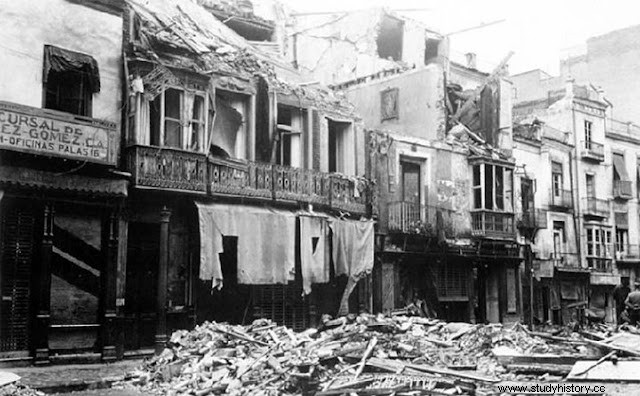
During the Spanish Civil War, the city of Almería was territorially framed in the Republican rearguard. And so it would remain practically until the end of the contest.
It all starts with the Deutschland incident. The government of the Republic had notified Italy and Germany that the port of Palma de Mallorca was not open for visits by foreign ships that could use it to unload war material. On May 24, 1937 the Italian ship "Barletta", moored in Palma de Mallorca, was attacked by republican planes, suffering 6 casualties. On the 26th the German patrol ship Albatross was also attacked. The Germans protested this attack and threatened reprisals if similar attacks were repeated.
On May 29, 1937, a squadron of republican Tupolev SB-2 (Katiuskas) bombers took off to pursue a flotilla of the rebel navy that was operating in the Mediterranean, among which was the cruiser Canarias. Shortly afterwards two planes returned and the Russian crew of one of them said that they had bombed the Canarias. Apparently the crews saw the ship anchored near Ibiza and firing at them with its anti-aircraft artillery. The first plane dropped its bombs, which missed; The second made a first pass and in a second launched its bombs, one of which hit near the funnel and the other near the bow. But the ship that received the impacts was not the Canarias cruiser, but the German cruiser Deutschland. The ship suffered serious material damage and there were 31 deaths and 74 injuries. Despite the long controversy surrounding this attack, the German ship failed to comply with the regulations of the Non-Intervention Committee to remain at least ten miles from the Spanish coast.
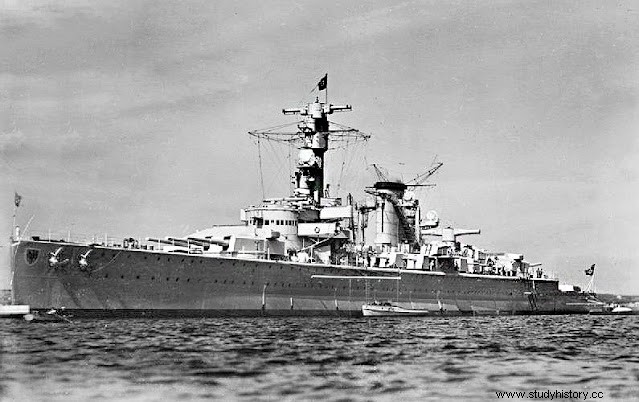 The Deutschland in 1936
The Deutschland in 1936Indalecio Prieto tried to justify the bombing by saying that the Katiuskas were reconnaissance planes and they were attacked earlier by the German battleship. Being informed about the event and the death of so many Germans, Hitler flew into a rage, and the German Foreign Minister needed six hours to try to calm him down. Due to the excitement, Hitler ordered the bombing of Valencia (seat of government) as compensation for this attack, as well as Cartagena. However, after being advised by his military advisers, especially Erich Raeder, he decided to bomb Almería, as this was a city without important military defenses and to avoid a great international echo. On the other hand, Almería was within the German maritime control zone.
Battles of Hispania Official Shop
In the early hours of May 31, the Germans took their revenge. The pocket battleship Admiral Scheer appeared alongside four German destroyers, the Albatross, Leopard, Seeadler and Lluchs, which were following a course that would raise little suspicion, as if wanting to continue along the coast towards the Strait of Gibraltar; but suddenly they made a sharp turn to the north. At 5:30 a.m. the five ships that were seen appearing on the horizon from the east and that, once they had passed Cabo de Gata, crossed the bay, turned in front of Roquetas and approached the city. Overcoming the castle of San Telmo, about seven miles from the coast (twelve kilometers), they fanned out in combat formation. At that point, the flag of the five ships, the German flag with the swastika, could already be clearly distinguished.
At 7:29 in the morning they opened fire on the port facilities and any ship that was in the port, including a small submarine, although its main objective was the Jaime I, which had left for Cartagena for repairs. Later, the coastal batteries gave away their position by unsuccessfully trying to repel the attack, so they became a new target. The ships fired calmly in the midst of the terror of the Almeria. The shells were combing the city from west to east and from south to north, in a fan pattern with shots from a parabola.
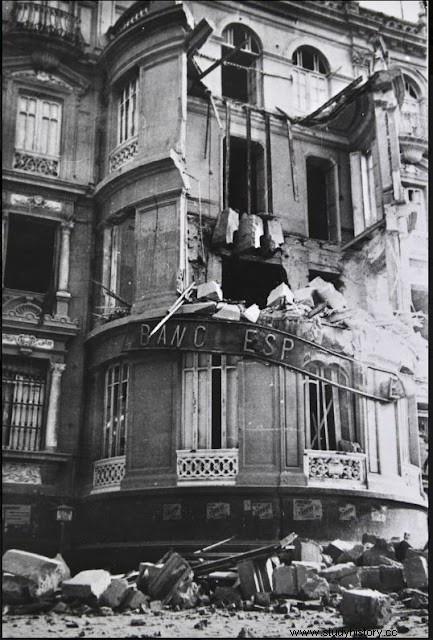 Bank of Spain Building
Bank of Spain BuildingDramatic scenes were experienced. On Almanzor street, some neighbors watched in disbelief as a municipal guard, Pío Rodríguez Monroy, took three steps without his head before falling to the ground. A shell had mowed down his body at the height of his neck. In the Port, a wounded carabinero who was being transferred on a car to the Casa de Socorro was hit by a bomb that fell right next to the improvised stretcher. No less than three bodies disappeared, that of two assault guards at the Station and that of a fortification worker. The bombs fell right on top of them.
The German squad fired a total of more than 200 shots before retreating in the face of increasing activity from Republican coastal anti-aircraft batteries. Ultimately, the attack resulted in 31 deaths, 55 injuries and 35 buildings destroyed. Unlike what happened weeks before in Guernica with the planes of the Condor Legion, the German ships at no time hid their nationality, nor did they pretend to act as subordinate support to the rebel side, but rather as a naval force that executed direct orders from the III Reich.
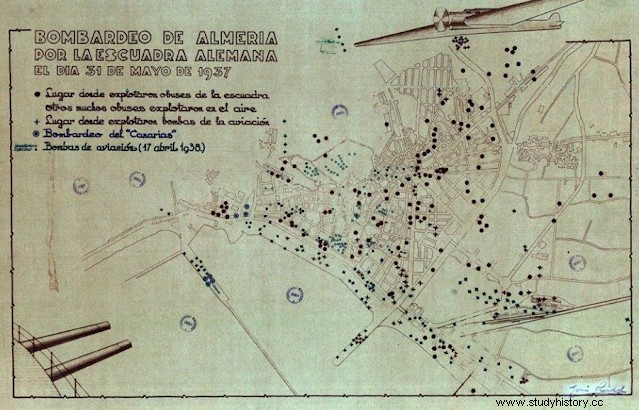 Map of the bombing of May 31
Map of the bombing of May 31Almería was in chaos while, at 6:50 hours later, the German ships stopped firing, turned and withdrew through Cabo de Gata. The bombardment lasted almost an hour and the 275 shots that were fired, 94 of them with 280-millimeter cannons, fell on the city, without the coastal batteries being able to do anything because their cannons did not have enough range to reach where it was. the German flotilla.
The civilian casualties could have been considerably higher if the bombing had occurred during working hours, because there were many Almerian who, precisely to avoid the consequences of the recent frequent attacks on the city, slept in the farmhouses of around, mainly in the river area.
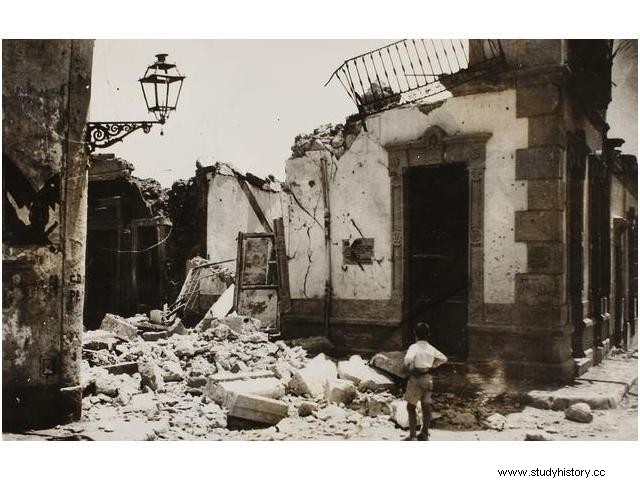 The Council of Ministers of the Republic met in Valencia, where Prieto (Minister of National Defense) proposed that the Republic to bombard the German fleet in the Mediterranean. Without a doubt, that could cause a world war, he acknowledged, but the risk was worth it. Negrín replied, cautiously, that it would be necessary to consult with the President of the Republic, Azaña, consulting also the communist ministers with Moscow. In this sense, the Soviet leaders were totally opposed to a conflict with Germany, in the same way that Azaña was:"We have to prevent Deutschland from becoming our Maine..."
The Council of Ministers of the Republic met in Valencia, where Prieto (Minister of National Defense) proposed that the Republic to bombard the German fleet in the Mediterranean. Without a doubt, that could cause a world war, he acknowledged, but the risk was worth it. Negrín replied, cautiously, that it would be necessary to consult with the President of the Republic, Azaña, consulting also the communist ministers with Moscow. In this sense, the Soviet leaders were totally opposed to a conflict with Germany, in the same way that Azaña was:"We have to prevent Deutschland from becoming our Maine..." In the end, Juan Negrín's position prevailed against turning the Spanish conflict into the germ of a European war, suspecting that Great Britain and France could even maintain their appeasement policy towards Hitler to the point of denying support for the Spanish Republic.
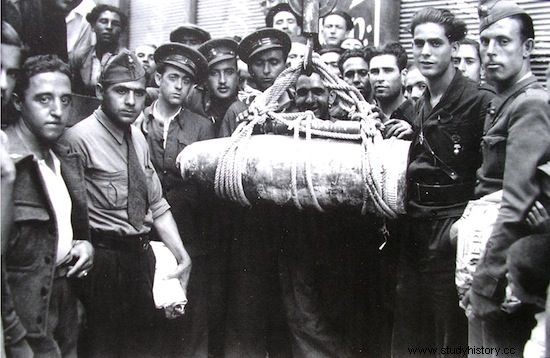 Militians from Almeria holding a bomb that did not explode
Militians from Almeria holding a bomb that did not explodeProtests by the government of the Republic over the bombing of Almería were only processed through diplomatic channels. But that "did not change the position of the democratic powers at all:France and England were in favor of moderation so that the Spanish conflict would not spread. They considered the incident settled. For its part, the Francoist government, both in its headquarters in Salamanca as well as from the Burgos technical board or the different diplomatic representations abroad, kept absolute silence.
Although the attack on Almería triggered numerous condemnations among international public opinion, no serious action was taken by the governments of Western democracies (Britain, France and the USA) Great Britain, through its ambassador in Berlin (Sir Neville Henderson), tried to appease the Germans not to do the Reds a favor by turning the situation international Spanish in a world war.
Before the German bombardment the city of Almería had already suffered some bombardments, but none of such intensity.For this reason, in 1937 Some underground galleries were built to shelter the population, designed by the architect Guillermo Langle. Using unusual mining techniques, Langle built four and a half kilometers of tunnels that could provide protection to 90% of a population of about 45,000 inhabitants. The infrequent nature of the initiative and the effectiveness and magnitude of the work have led to reconsidering the cultural and historical importance of these shelters, which today can be visited in the capital of Almería.
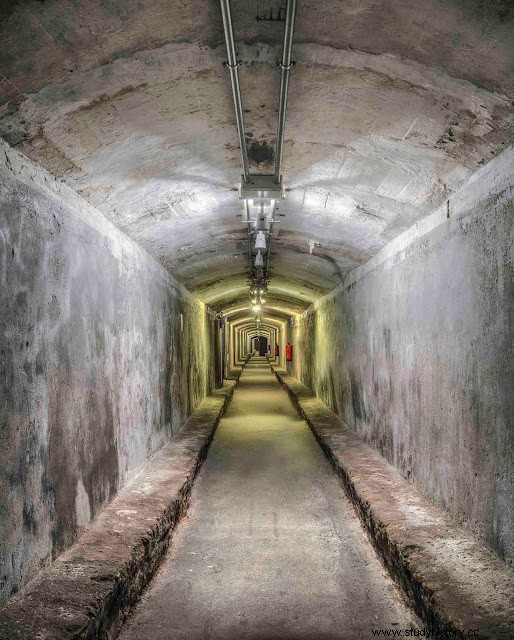 Refugios de Almería
Refugios de Almería| Date | May 31, 1937 | |||
|---|---|---|---|---|
| Place | Almería, (Spain) | |||
| Coordinates |  36°50′00″N 2°27′00″OCoordinates: 36°50′00″N 2°27′00″OCoordinates: 36°50′00″N 2°27′00″W (map) 36°50′00″N 2°27′00″W (map) | |||
| Result | Severe damage in the city. | |||
| Belligerents | ||||
| ||||
| Commanders | ||||
| ||||
| Forces in combat | ||||
| ||||
| Lowers | ||||
| ||||

 Spanish Republic
Spanish Republic Nazi Germany
Nazi Germany